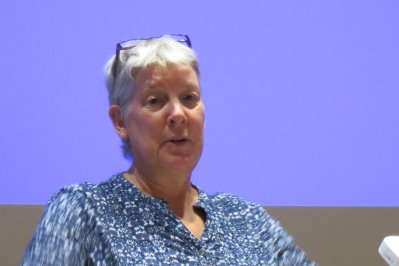 This year's FishBase and SeaLifeBase Symposium stretched over two days and thus offered a wider array of talks and interaction than previous occasions. It took place at the Indian Ocean Research Centre (IOMRC) of the University of Western Australia (UWA), Perth, from 9 to 10 September. Peter Veth, Director, and Jessica Meeuwig, Head of the Marine Futures Lab, welcomed speakers and other participants with the usual "acknowledgement of nation". Read on for a few highlights.
This year's FishBase and SeaLifeBase Symposium stretched over two days and thus offered a wider array of talks and interaction than previous occasions. It took place at the Indian Ocean Research Centre (IOMRC) of the University of Western Australia (UWA), Perth, from 9 to 10 September. Peter Veth, Director, and Jessica Meeuwig, Head of the Marine Futures Lab, welcomed speakers and other participants with the usual "acknowledgement of nation". Read on for a few highlights.
Daniel Pauly, leader of the Sea Around Us Project and one of the "fathers of FishBase" opened the series of scientific presentations by recalling the time before FishBase, that is some 30 years ago. Fisheries research took place mostly in industrialised countries publishing their results in specialised journals which were expensive to subscribe to. Scientists in developing countries were few and their laboratories could mostly not afford to pay the going subscription rates. Sometimes these scientists could not even afford the stamps for the postcard asking for a reprint of articles in expensive journals. Their access to the scientific knowledge of the time was indirect through the valuable services of FAO and librarians putting out ASFA (Aquatic Science and Fisheries Abstracts). So they could learn about fisheries research, but rarely get "the real thing" in the form of direct access to the publications.
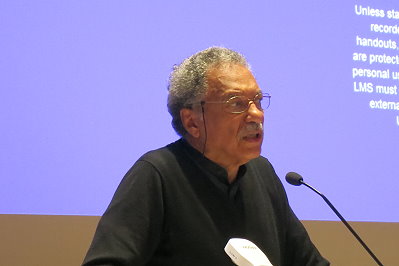 In this context, creating direct access to basic information about the biology, distribution, growth and other parameters of fish that do not change every year by providing the content of a large number of scientific publications in the format of a searchable database was a major break-through.
In this context, creating direct access to basic information about the biology, distribution, growth and other parameters of fish that do not change every year by providing the content of a large number of scientific publications in the format of a searchable database was a major break-through.
FishBase now has more than 10,000 citations in google scholar, an achievement reached very rarely.
The biggest challenge throughout the 29 years of its existence has always been to secure funding for the encoding staff in the Philippines without who it would not be the treasure trove it has become.
The second biggest challenge is to improve coverage of ALL countries around the globe. The original focus of inputting data into FishBase were the African, Caribbean and Pacific (ACP) countries as the early development and training efforts were funded by the European Development Fund upon their request.
As a result of this and continued efforts to cover also other developing countries on the assumption that wealthy countries could do their own coverage, the latter turned out, however, not to have their fish fauna sufficiently represented. It was therefore a welcome opportunity to develop an excellent collaboration with the University of Western Australia and some other (Australian) research institutions. This allows to make a targeted effort for inclusion of a wealth of information of fish data in FishBase and invertebrate and seabird data in SeaLifeBase. Similar collaborative efforts are required for the US and other industrialised countries.
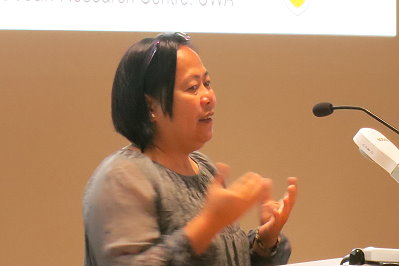 As world fisheries are in decline as a result of widespread overfishing despite modest signs of recovery in a few regions around the US, Canada and Australia, while Latin America, Africa, India and waters around Asia are in increasingly lamentable shape, the sciences must be decidedly conservation-oriented. The earlier focus on expanding production has become completely counterproductive.
As world fisheries are in decline as a result of widespread overfishing despite modest signs of recovery in a few regions around the US, Canada and Australia, while Latin America, Africa, India and waters around Asia are in increasingly lamentable shape, the sciences must be decidedly conservation-oriented. The earlier focus on expanding production has become completely counterproductive.
As climate change and the associated warming of ocean waters drive changes in the distribution of fish and invertebrate species, which move polewards to remain within their preferred temperature range, science must work for global equity to avoid that rich and poor nations drift further apart.
One such effort that can support resource assessments in data poor situations in developing countries was shown by Rainer Froese, the other "father of FishBase" based at GEOMAR. Together with colleagues, he developed a Bayesian assessment (CMSY), a self-learning system able to provide relevant information to managers based on their prior knowledge about the resources and information mostly already contained in FishBase. The method has already been successfully applied on 397 European stocks (many not regularly assessed) and in collaboration with Indian colleagues on their fisheries data. A training course for West African scientists and data managers is forthcoming.
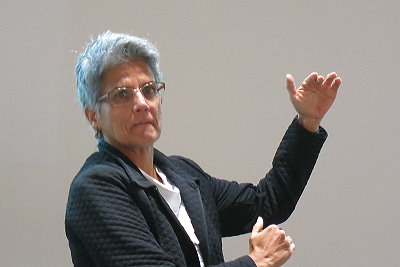 Maria Lourdes (Deng) Palomares, also of the Sea Around Us, showed how biomasses of fish species both in temperate and tropical regions are shrinking. Only about 20% of 1320 stocks already analysed were in good biological state, 8% were below safe biological limits. These findings underscored the urgency of conservation and restoration efforts.
Maria Lourdes (Deng) Palomares, also of the Sea Around Us, showed how biomasses of fish species both in temperate and tropical regions are shrinking. Only about 20% of 1320 stocks already analysed were in good biological state, 8% were below safe biological limits. These findings underscored the urgency of conservation and restoration efforts.
Katia Freire of the University of Sergipe in Brazil elaborated on the enormous difficulties to match local names with scientific names and clarify which species the catch reports should be attributed to. Across the country marine species had an average of six vernacular or commercial names; reef associated species had more than seven vernacular names and freshwater species three (though that may increase with more studies of inlandwater species.
Some species may have much higher numbers of vernacular names in different states of Brazil, e.g. Macrodon ancylodon has 37 registered common names. In other cases, several species are lumped together under the vernacular name of a highly priced species. All these mislabellings represent a serious challenge to reconciling national (federal) and state statistics and make sound scientific advice to managers more difficult.
Jos Snoeks of the Royal Museum for Central Africa (MRAC) in Belgium reported about the successful training of francophone and anglophone African scientists in fish identification and use of FishBase. This work, supported by the Belgian development cooperation was improving the coverage of freshwater fishes, though the on-going speciation processes made the distinction of individual species often very difficult or even impossible.
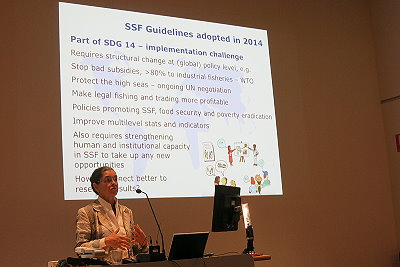 Cornelia E Nauen of Mundus maris asbl reported on progress in the pilot phase of the small-scale fisheries academy in Senegal which aims to support the implementation of the SSF Guidelines as part of SDG14.
Cornelia E Nauen of Mundus maris asbl reported on progress in the pilot phase of the small-scale fisheries academy in Senegal which aims to support the implementation of the SSF Guidelines as part of SDG14.
While global policy change is indispensible, e.g. phasing out bad subsidies for industrial fishing in the World Trade Organization (WTO), it is important to enhance the capacities of small-scale fishing communities and the men and women in SSF value chains so that they can take advantage of any opportunities arising.
Making use of modern information technology, e.g. in the form of an app providing access to key information in FishBase, is one of several initiatives of the academy. Search results should use as much as possible visual representations to reduce the need for reading proficiency and translation. Information on minimum length (showing the picture of the fish with a ruler) and resilience (duplication time of a population as an indicator for vulnerability to fishing pressure) could be useful not only in SSF, but also in schools as part of improving ocean literacy and in complement to the teaching kit on the ecosystem approach to fisheries earlier developed for FAO's Nansen project. The slides of the talk can be seen here.
Amy Mcalpine of UWA gave an excellent presentation about how to improve the taxonomic resolution of Kenyan catches, 90% of which are from small-scale fisheries while Neil Loneragan of Murdoch University spoke about Western Australian biodiversity, but also on how to improve the knowledge about Indonesian fish fauna and catches, a country with the 6th biggest EEZ in the world.
The symposium brought to the light quite a number of newer insights, but conveyed also the sense of what still needed to be done - on the side of documenting basics of marine life as much as on the side of efforts to share results as widely as possible with ordinary citizens so that they can partake in appreciating the wonders of marine life, enjoy healthy seafood, but also engage in ocean protection.








